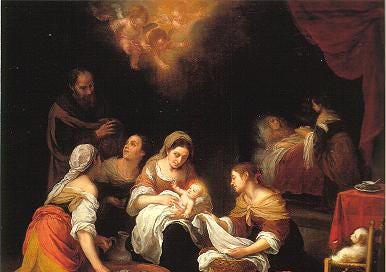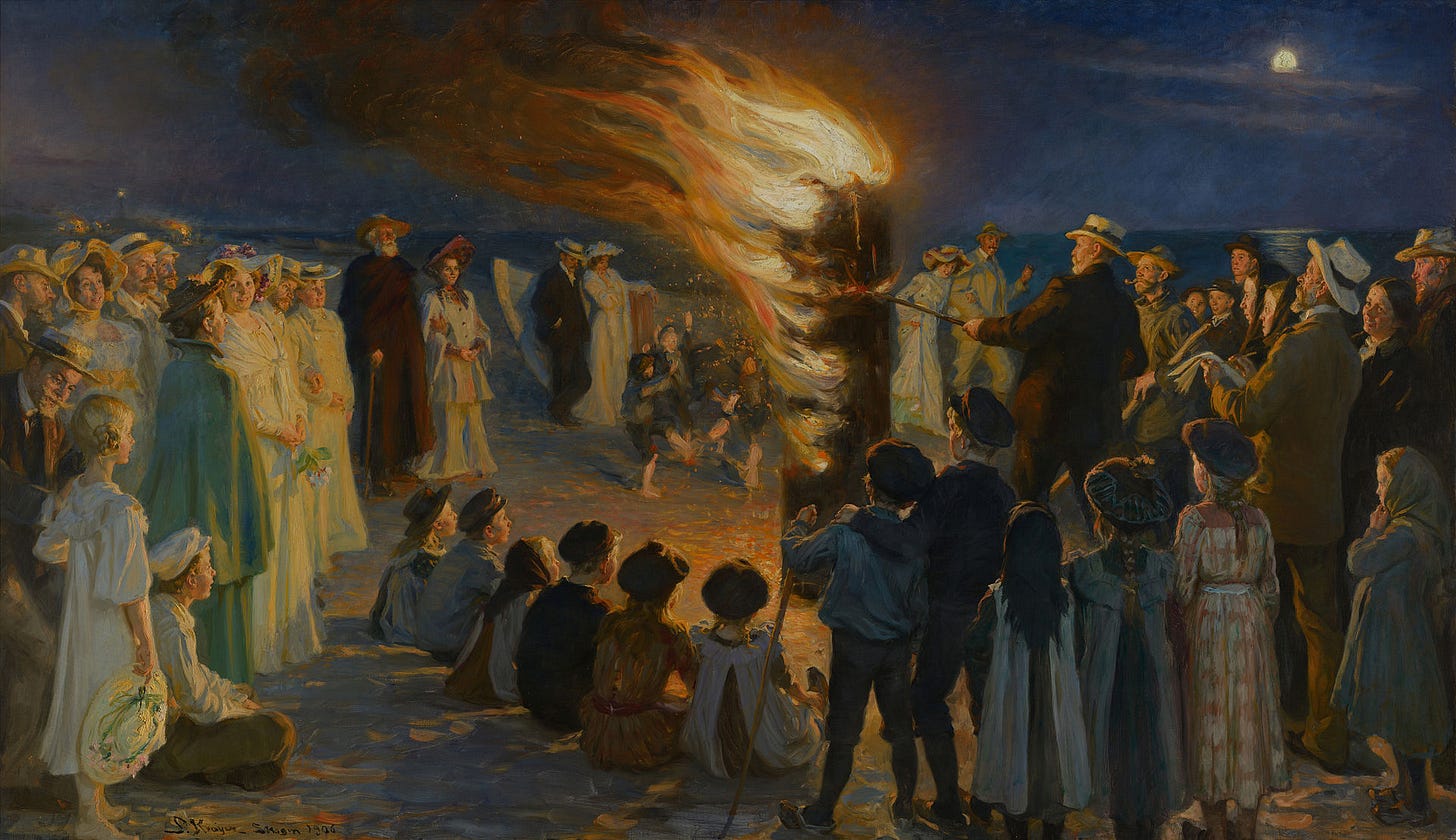Happy St. John's Eve!
There was in the days of Herod the King of Judea, a certain priest named Zachary, of the course of Abia, and his wife was of the daughters of Aaron, and her name Elizabeth. And they were both just before God, walking in all the commandments and justifications of the Lord without blame. And they had no son, for that Elizabeth was barren, and they both were well advanced in years. And it came to pass, when he executed the priestly function in the order of his course before God, according to the custom of the priestly office, it was his lot to offer incense, going into the temple of the Lord; and all the multitude of the people was praying without, at the hour of incense. And there appeared to him an Angel of the Lord, standing on the right side of the altar of incense. And Zachary seeing him was troubled, and fear fell upon him; but the Angel said to him: Fear not, Zachary, for thy prayer is heard; and thy wife Elizabeth shall bear thee a son, and thou shalt call his name John: and thou shalt have joy and gladness, and many shall rejoice in his nativity. For he shall be great before the Lord: and shall drink no wine nor strong drink: and he shall be filled with the Holy Ghost even from his mother’s womb. And he shall convert many of the children of Israel to the Lord their God. And he shall go before him in the spirit and power of Elias; that he may turn the hearts of the fathers unto the children, and the incredulous to the wisdom of the just, to prepare unto the Lord a perfect people.
— Luke 1:5-17
This Feast, then, follows the Feast of the Annunciation by 3 months and precedes the birth of Christ by six months. It is providential that the Feast of "the Forerunner," the greatest of all Prophets, should fall at Midsummer, around the Summer Solstice 1 when the days become shorter, because of his words in John 3:30, "He must increase, but I must decrease." Conversely, Our Lord, the "Radiant Dawn," was born at the Winter Solstice, when the days were becoming longer!1
On St. John's Eve and Day, it is customary to gather the perennial herb "St. John's Wort" (Hypericum perforatum), named for our Saint. It's long been seen as a means to keep evil away, and since medieval times, the herb has been hung over doors, windows and icons (its genus name -- hypericum -- means "above a picture") to keep witches and evil spirit away. It is also used medicinally, and was used thus by the Knights Hospitallers. To harvest, cut off the top third of the plant and hang in bundles to dry.
In addition to gathering St. John's wort, it's also customary to gather flowers to make wreaths to wear and to hang in your home or, especially, on the front door. Make a wreath of flowers that dry well, and hang in your home all year to be replaced next St. John's Day. Alternatively, flowers can be tied together in bunches with beautiful ribbons and hanged upside-down to decorate your home all year. 2 Swedish girls will pick seven flowers from seven different fields, and place them under their pillows on this night so they will dream about their future husbands, and in Slavic countries, such as Poland, floral wreaths are floated down the river in honor of Christ's Baptism by St. John in the Jordan.
Italian women will get a big, glass or clay basin, fill it with freshly-picked herbs and flowers (especially lavender, St. John's wort, rosemary, and mint), and leave it outside overnight, uncovered, on St. John's Eve to collect the dew of St. John's morning. Washing one's face and hands with this flora and dew-infused water is said to be beneficial. In Messina, Sicily, in a tradition that undoubtedly goes far back into pre-Christian times, women will prepare muzzuni on St. John's Eve: they take a large clay vase that has been severed at its neck in honor of St. John's fate (which we recall on August 29), fill it with wheat, lavender, carnations, and barley and wheat stems that have been sprouted in the dark. They then wrap the bottle in silk cloth and adorn it with metals and jewels to place on tables -- between two candles -- that have been set up around the town.
Flowers and herbs aside, the temporal focal point of the festivities, is the building of fires outdoors in which to burn worn out sacramentals and to serve as a symbol of the one Christ Himself called "a burning and shining light" (John 5:35). These fires used to be huge, communal bonfires, and this still occurs in parts of Europe, but smaller, "family-sized" fires will do, too. The fire, built at dusk -- and preferably lit by a man named John (Jean, Giovanni, Juan, etc.) -- is blessed with this blessing from the Roman Ritual, and allowed to burn past midnight…
P: Our help is in the Name of the Lord.
All: Who made heaven and earth.
P. The Lord be with you.
All. And with thy spirit. The fire is sprinkled with holy water;
after which the clergy and the people sing the "Ut queant laxis"
Ut queant laxis resonáre fibris
Mira gestórum fámuli tuórum,
Solve pollúti lábii reátum,
Sancte Joánnes.
Núntius celso véniens Olýmpo
Te patri magnum fore nascitúrum,
Nomen, et vitae sériem geréndae
Ordinae promit.
Ille promíssi dúbius supérni,
Pérdidit promptae módulos loquélae:
Sed reformásti genitus perémptae
Organa vocis.
Ventris obstrúso récubans cubíli
Sénseras Regem thálamo manéntem:
Hinc parens nati
méritis utérque Abdita pandit.
Sit decus Patri, genitaéque Proli
et tibi, compare utriúsque virtus,
Spíritus semper, Deus unus, omni
Témporis aevo. Amen.
O for your spirit, holy John, to chasten
Lips sin-polluted, fettered tongues to loosen;
So by your children might your deeds of wonder
Meetly be chanted.
Lo! a swift herald, from the skies descending,
Bears to your father promise of your greatness;
How he shall name you, what your future story,
Duly revealing.
Scarcely believing message so transcendent,
Him for a season power of speech forsaketh,
Till, at your wondrous birth, again returneth,
Voice to the voiceless.
You, in your mother's womb all darkly cradled,
Knew your great Monarch, biding in His chamber,
Whence the two parents,
through their offspring's merits, Mysteries uttered.
Praise to the Father, to the Son begotten,
And to the Spirit, equal power possessing,
One God Whose glory, through the lapse of ages,
Ever resounding.Let us pray. Lord God, almighty Father, the light that never fails and the source of all light, sanctify + this new fire, and grant that after the darkness of this life we may come unsullied to Thee Who art light eternal; through Christ our Lord.
All: Amen. P: There was a man sent from God.
All. Whose name was John.
Let us pray. God, Who by reason of the birth of blessed John have made this day praiseworthy, give Thy people the grace of spiritual joy, and keep the hearts of Thy faithful fixed on the way that leads to everlasting salvation; through Christ our Lord.
All: Amen.
After the blessing, a decade of the Rosary is prayed while walking sunwise -- clockwise, around the fire. Then old Sacramentals are reverently burned, but other things are tossed into the fire as well: in Ireland, the youngest able child tosses into the flames a bone -- symbolizing the end of the Old Covenant and the beginning of the New.
St John’s Eve was also a time when witches and the fairy folk were particularly active. The unwary in Wales who went out to gather herbs might find themselves taken for a ride on a fairy horse should they unwittingly tread on one of the St John’s plants. Shakespeare’s A Midsummer Night’s Dream was set on this night for this very reason – 16th century audiences were very much aware of these beliefs. Indeed, they were as omnipresent in Europe as the fires themselves. Washington Irving, in his short piece “Christmas Dinner,” relates how the servants of the Manor House in which he was staying (actually Aston Hall, near Birmingham) believed that on “Midsummer Eve, when it was well known all kinds of ghosts, goblins, and fairies become visible and walk abroad…” Similar beliefs could – and can - be found all the way across Europe to Russia, where Gogol wrote his chilling “St John’s Eve” and Modest Mussorgsky composed Night on Bald Mountain (immortalized by the inclusion of Tchaikovsky’s version in Walt Disney’s Fantasia) inspired by local folk beliefs. So it is that in many places, St John’s Eve is – as with Christmas Eve, May Eve, and Halloween – seen as a great time for telling ghost stories and other tales of the uncanny, often having to do with legends peculiar to the neighbourhood.2
Another interesting thing about the Feast of St. John: the Breviary's hymn for this day, Ut queant laxis -- the hymn sung or recited during the blessing of the bonfire -- is the source of our names of musical notes -- Do, Re, Mi, Fa, So, La, Ti, Do. The hymn, attributed to Paulus Diaconus (Paul the Deacon, ca. A.D. 720-799), was noted by a monk to rise one note in the diatonic C-Scale with each verse. The syllables sung at each rise in pitch give us the names of our notes (the "Ut" was later changed to "Do" for easier pronunciation):
Ut queant laxis
Resonare fibris
Mira gestorum
Famuli tuorum,
Solve polluti
Labii reatum, Sanc
Te Ioannes
https://fisheaters.com/customstimeafterpentecost3.html#1
https://lms.org.uk/massofagesarticle/st-johns-magical-eve








